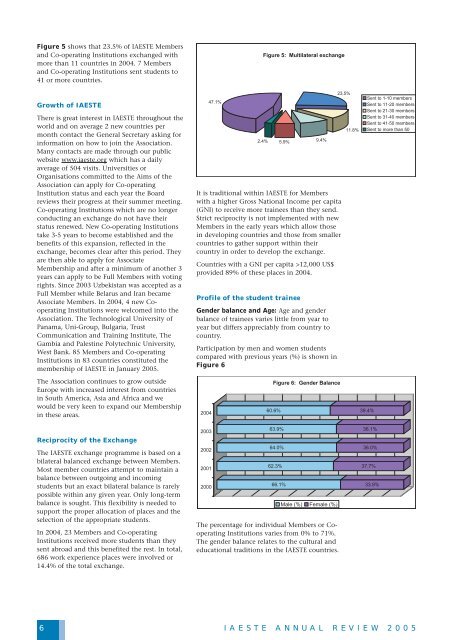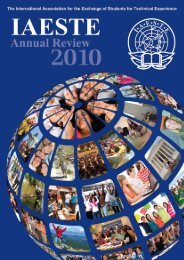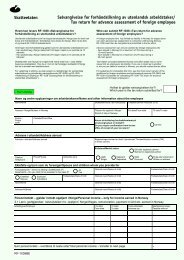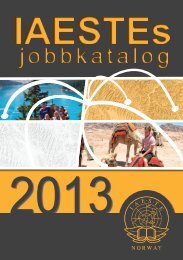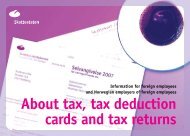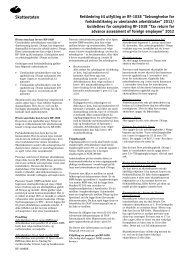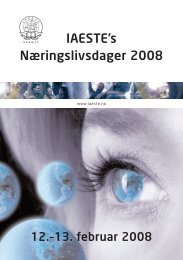View Annual Review - IAESTE
View Annual Review - IAESTE
View Annual Review - IAESTE
Create successful ePaper yourself
Turn your PDF publications into a flip-book with our unique Google optimized e-Paper software.
Figure 5 shows that 23.5% of <strong>IAESTE</strong> Members<br />
and Co-operating Institutions exchanged with<br />
more than 11 countries in 2004. 7 Members<br />
and Co-operating Institutions sent students to<br />
41 or more countries.<br />
Growth of <strong>IAESTE</strong><br />
There is great interest in <strong>IAESTE</strong> throughout the<br />
world and on average 2 new countries per<br />
month contact the General Secretary asking for<br />
information on how to join the Association.<br />
Many contacts are made through our public<br />
website www.iaeste.org which has a daily<br />
average of 504 visits. Universities or<br />
Organisations committed to the Aims of the<br />
Association can apply for Co-operating<br />
Institution status and each year the Board<br />
reviews their progress at their summer meeting.<br />
Co-operating Institutions which are no longer<br />
conducting an exchange do not have their<br />
status renewed. New Co-operating Institutions<br />
take 3-5 years to become established and the<br />
benefits of this expansion, reflected in the<br />
exchange, becomes clear after this period. They<br />
are then able to apply for Associate<br />
Membership and after a minimum of another 3<br />
years can apply to be Full Members with voting<br />
rights. Since 2003 Uzbekistan was accepted as a<br />
Full Member while Belarus and Iran became<br />
Associate Members. In 2004, 4 new Cooperating<br />
Institutions were welcomed into the<br />
Association. The Technological University of<br />
Panama, Uni-Group, Bulgaria, Trust<br />
Communication and Training Institute, The<br />
Gambia and Palestine Polytechnic University,<br />
West Bank. 85 Members and Co-operating<br />
Institutions in 83 countries constituted the<br />
membership of <strong>IAESTE</strong> in January 2005.<br />
It is traditional within <strong>IAESTE</strong> for Members<br />
with a higher Gross National Income per capita<br />
(GNI) to receive more trainees than they send.<br />
Strict reciprocity is not implemented with new<br />
Members in the early years which allow those<br />
in developing countries and those from smaller<br />
countries to gather support within their<br />
country in order to develop the exchange.<br />
Countries with a GNI per capita >12,000 US$<br />
provided 89% of these places in 2004.<br />
Profile of the student trainee<br />
Gender balance and Age: Age and gender<br />
balance of trainees varies little from year to<br />
year but differs appreciably from country to<br />
country.<br />
Participation by men and women students<br />
compared with previous years (%) is shown in<br />
Figure 6<br />
The Association continues to grow outside<br />
Europe with increased interest from countries<br />
in South America, Asia and Africa and we<br />
would be very keen to expand our Membership<br />
in these areas.<br />
Reciprocity of the Exchange<br />
The <strong>IAESTE</strong> exchange programme is based on a<br />
bilateral balanced exchange between Members.<br />
Most member countries attempt to maintain a<br />
balance between outgoing and incoming<br />
students but an exact bilateral balance is rarely<br />
possible within any given year. Only long-term<br />
balance is sought. This flexibility is needed to<br />
support the proper allocation of places and the<br />
selection of the appropriate students.<br />
In 2004, 23 Members and Co-operating<br />
Institutions received more students than they<br />
sent abroad and this benefited the rest. In total,<br />
686 work experience places were involved or<br />
14.4% of the total exchange.<br />
The percentage for individual Members or Cooperating<br />
Institutions varies from 0% to 71%.<br />
The gender balance relates to the cultural and<br />
educational traditions in the <strong>IAESTE</strong> countries.<br />
6 I A E S T E A N N U A L R E V I E W 2 0 0 5


